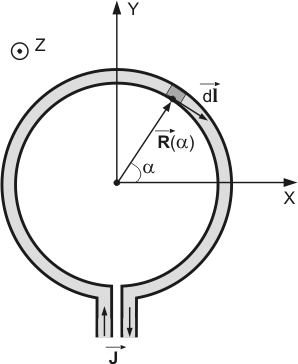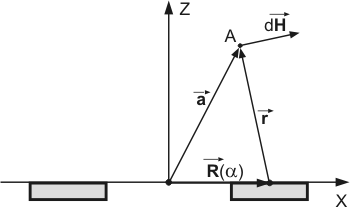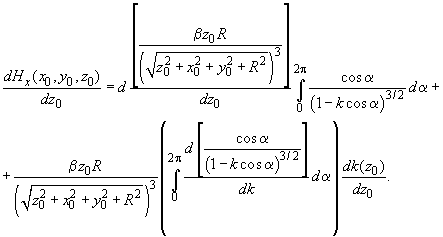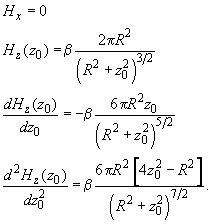2.7.10 Magnetic field of ring with current
Let us calculate the magnetic field generated by direct current
 passing through a ring of radius
passing through a ring of radius
 (Fig. 1). Let the width and thickness of a conductor be much less than
(Fig. 1). Let the width and thickness of a conductor be much less than
 .
.

Fig. 1. Schematics of ring with current.

Fig. 2. Cross-section of the ring.
According to the Biot-Savart-Laplace law [1,2], the magnetic field produced by a current-carrying wire element of length
 at distance
at distance
 from it in Gaussian coordinates is given by
from it in Gaussian coordinates is given by

(1)
where
 ,
,
 – light velocity.
– light velocity.
Placing the right-hand coordinate system XYZ into the ring center so that the XY plane lies in the ring plane (Fig. 1, 2) and noting that the problem is symmetrical relative to the ring center, it is enough to determine the magnetic field distribution in a plane containing vector codirectional with the ring radius and the Z-axis. For mathematical convenience we can choose the plane XZ and determine the magnetic field at point
 as shown in Fig. 2. The radius-vector
as shown in Fig. 2. The radius-vector
 from point
from point
 to the ring element
to the ring element
 as a function of angle
as a function of angle
 is given by the following expression
is given by the following expression

(2)
Elementary vector
 as a function of
as a function of
 and angle
and angle
 is written as follows:
is written as follows:

(3)
Substituting expressions (2) and (3) into formula (1), we get

(4)
To determine the total magnetic field produced by all the ring at point
 , one needs to integrate every component of vector
, one needs to integrate every component of vector
 with respect to
with respect to
 from 0 to 2p. Then, the components X, Y and Z of vector
from 0 to 2p. Then, the components X, Y and Z of vector
 in accordance with (4) are defined as:
in accordance with (4) are defined as:

(5)
where
 .
.
Formulas (5) give the magnetic field distribution in the XZ plane. It is clear that due to the problem symmetry, the magnetic field along the Y-axis is zero and at an arbitrary point
 it is equal to that at point
it is equal to that at point
 in the XZ-plane. Accordingly, formulas (5) are rewritten as:
in the XZ-plane. Accordingly, formulas (5) are rewritten as:

(6)
where
 .
.
Because
 behaves as a parameter in the integrand of functions
behaves as a parameter in the integrand of functions
 and
and
 , the first and second Z-derivatives of the magnetic field components can be obtained by direct differentiation of functions
, the first and second Z-derivatives of the magnetic field components can be obtained by direct differentiation of functions
 ,
,
 with respect to
with respect to
 and subsequent numerical integration. For example, the first
and subsequent numerical integration. For example, the first
 -derivative of
-derivative of
 in accordance with (6) is given by:
in accordance with (6) is given by:

(7)
The other components of vector
 are calculated similarly. In case
are calculated similarly. In case
 ,
,
 (point
(point
 is on the ring axis) formulas (6,7) are transformed as follows
is on the ring axis) formulas (6,7) are transformed as follows

(8)
Using analitical expressions of the magnetic field first and second Z-derivates, one can calculate the interaction force (and its first derivative) between magnet probe and rectangular conductor with current. These calculations for different probe geometry are given in Appendix.
Summary.
- Derived are formulas (6-8) for the spatial distribution of the magnetic field and its derivatives along the Z-axis over a current ring.
References.
- D.V. Sivukhin. Electricity (General course of physics). Moscow, Nauka 1983. - 688 pp. (in Russian).
- R. Feinman, R. Leitos, M. Sands The Feinman lectures on physics. Electricity and magnetism. Moscow, MIR 1977. - 299 pp.






